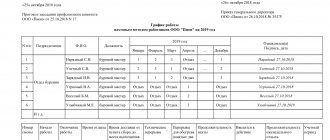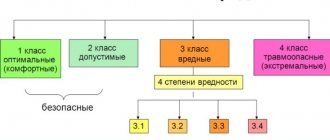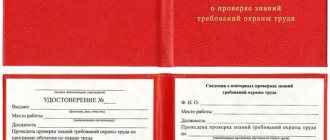Documents of international organizations on women's labor protection
The need for labor protection for women is enshrined in documents of international organizations, in particular in the conventions of the International Labor Organization:
- ILO Maternity Protection Convention No. 3 (1919);
- ILO Convention No. 4 concerning Women's Night Work (1919);
- ILO Convention No. 41 (Revised) concerning Women's Night Work (1934);
- European Convention for the Protection of Human Rights and Fundamental Freedoms (1950);
- ILO Convention No. 100 concerning equal remuneration for men and women (1951);
- ILO Declaration on Equality of Opportunity and Treatment for Women Workers (1975);
- UN Convention on the Elimination of All Forms of Discrimination against Women (1979), etc.
Restrictions regarding working conditions
Features of women's labor protection in the Labor Code of the Russian Federation include a ban on attracting female workers to work in underground mines, as well as to work in dangerous, harmful conditions. Exceptions are sanitary services and non-physical work in these cases.
The basic features of women’s labor protection are a number of conditions for their work in rural areas. For example:
- A ban on training and hiring women to work as truck drivers and tractor drivers.
- Workers under 35 years of age cannot participate in work activities related to pesticides, disinfectants, and toxic chemicals.
- Pregnant women are prohibited from working in the fields of crop production and livestock farming.
If we look at the features of labor protection for women in kindergarten, then here, as elsewhere, the worker’s ability to perform physical activity is taken into account. Legislation also tries to minimize the negative impact of work on reproductive function.
It is also important to remember that in our country in 1996, hygiene requirements were introduced for the organization of women’s workplaces. They set the optimal air temperature for work, workload standards, employment conditions for pregnant workers, etc.
Legal status of working women in the Russian Federation
Features of the organization of women's labor are legally defined in the Labor Code of the Russian Federation (Chapter 41). Labor legislation contains special norms aimed at protecting the labor and health of women.
In accordance with Art. 253 of the Labor Code of the Russian Federation limits the use of women's labor in heavy work and work with harmful and (or) dangerous working conditions, as well as in underground work, with the exception of non-physical work or work on sanitary and household services. The list of heavy work and work with harmful or dangerous working conditions, during which the use of women’s labor is prohibited, was approved by Decree of the Government of the Russian Federation of February 25, 2000 No. 162. However, the employer has the right to decide on the use of women’s labor in jobs (in professions, positions) included in the specified list, subject to the creation of safe working conditions, confirmed by the results of a special assessment of working conditions. It is prohibited to employ women in jobs involving lifting and manually moving heavy loads that exceed the maximum permissible standards for them. The standards for maximum permissible loads for women when lifting and moving heavy objects manually are approved by Decree of the Government of the Russian Federation dated 02/06/1993 No. 105. In particular, these standards establish the following maximum permissible load weight:
- when lifting and moving heavy objects when alternating with other work (up to twice an hour) – 10 kg;
- when lifting and moving heavy objects constantly during a work shift – 7 kg.
In addition, the amount of dynamic work performed during each hour of a work shift should not exceed:
- from the working surface – 1750 kgm;
- from the floor - 875 kgm.
In this case, the mass of the lifted and moved cargo includes the mass of containers and packaging. When moving loads on trolleys or in containers, the applied force should not exceed 10 kg. Thus, in accordance with current legislation, regardless of a woman’s wishes, an employment contract with her to perform certain types of work cannot be concluded. And we are not talking here about discrimination against women in the world of work, but about protecting their lives and health.
Regulatory acts
The basic labor protection standards are set out in Chapter 41 of the Labor Code of the Russian Federation. Article 253 of the Labor Code of the Russian Federation has the following restrictions:
- Prohibition on lifting weights weighing more than 15 kg, as well as carrying weights weighing more than 10 kg. These prohibitions apply only to occasional work with objects. If a woman constantly works with weight, it cannot exceed 7 kg. The restrictions themselves are set out in the article of the Labor Code of the Russian Federation, and specific standards for lifting weights are in the order of the Ministry of Labor dated September 17, 2014 No. 642n.
- Restrictions on work in difficult, dangerous and harmful conditions.
- A ban on working underground unless it is sanitary or domestic work.
Specific prohibitions were established by Resolution No. 162 of February 25, 2000. It sets out 456 specialties that are prohibited for women. Let's look at some of them:
- Boiler maintenance work.
- Steelworker.
- Working with explosives.
- Painter.
- Bulldozer driver.
In addition, women's work must comply with sanitary standards. They were established by Resolution No. 32 of the Sanitary and Epidemiological Supervision Authority of October 28, 1996. The employer must ensure compliance with the standards. The resolution sets out all the details. For example, SanPiN contains requirements for the chair on which a pregnant woman will sit. The document approves the following requirements:
- Noise indicators.
- Radiation indicator.
- Thermal loads.
- Industrial microclimate.
Some of the provisions of the Resolution of the Ministry of Labor on the standards of weights used were set out earlier. Let's look at others. The maximum weight per shift that a woman can move (but not lift) is 1,750 kg. The total weight allowed for lifting is 875 kg.
Employees are provided with a number of benefits. For persons working in the field of pedagogy and medicine, the working week is reduced to 36 hours. A similar benefit is provided to employees working in the Far North. The salary does not decrease. Rural workers can receive one additional day off per month based on an appropriate application. This benefit is approved by Article 262 of the Labor Code of the Russian Federation. There will be no paid time off.
ATTENTION! Prohibitions for pregnant women relate to physical limitations. For example, this is a ban on certain professions, lifting weights in excess of the recommended amount. Otherwise, the legislation does not contain restrictions or requirements to create special conditions for women, since the law provides for equality of employees of both sexes at work.
Occupational safety for pregnant women and women with children under one and a half years of age
What are the responsibilities of an employer towards pregnant women? Article 254 of the Labor Code of the Russian Federation regulates the procedure for transferring pregnant women and women with children under the age of one and a half years to easier work. For pregnant women, in accordance with a medical report and at their request, production standards or service standards are reduced. In addition, they can be transferred to another job that eliminates the impact of unfavorable production factors while maintaining the average earnings for their previous job. Until a pregnant woman is provided with another job that excludes exposure to adverse production factors, she is subject to release from work with the preservation of average earnings for all working days missed as a result at the expense of the employer. In accordance with Hygienic Recommendations, pregnant women should not perform operations related to: lifting objects of labor above the level of the shoulder girdle; lifting objects of labor from the floor; the predominance of static tension in the muscles of the legs and abdominals; forced working position (squatting, kneeling, bending, resting your stomach and chest on equipment and objects of labor); body tilt more than 15 degrees. In addition, pregnant women should be excluded from operating foot pedal operated equipment. Also, operations on a conveyor belt with a forced rhythm and work accompanied by nervous and emotional stress should be excluded. Current legislation establishes optimal working environment conditions for pregnant women, namely:
- Pregnant women should not be allowed to work in conditions where potentially hazardous chemicals are used in production, including allergenic and carcinogenic ones;
- It is prohibited to employ pregnant women under conditions of exposure to extremely and highly hazardous (hazard class I and II) chemicals, substances that have repulsive, disgusting odors, and those that do not have a toxicological assessment;
- Pregnant women are not allowed to perform work associated with exposure to pathogens of infectious, parasitic and fungal diseases;
- pregnant women working in production must be provided with optimal parameters of temperature, humidity and air mobility;
- Pregnant women should not work in conditions of exposure to infrared radiation, especially aimed at the abdomen and pelvis.
- Pregnant women are contraindicated in activities that involve getting their limbs, clothes and shoes wet, or in a draft; during pregnancy, women must be transferred to workplaces without exposure to vibration, ultrasound, or ionizing radiation;
- the noise intensity in the workplaces of pregnant women should not exceed 50–60 dBA;
- Pregnant women are not allowed to work at installations and structures that are sources of electromagnetic radiation, the parameters of which go beyond the optimal values established for residential premises;
- For women during pregnancy, working under conditions of sudden changes in barometric pressure is absolutely contraindicated;
- from the day pregnancy is established, women are prohibited from working under conditions of exposure to industrial aerosols of predominantly fibrogenic and mixed types of action; natural and artificial lighting of pregnant women’s workplaces must comply with the current optimal hygienic standards,
- Pregnant women are not allowed to work in windowless or lightless rooms (i.e., without natural light).
Limiting physical activity for pregnant workers
Features of labor protection for women working during pregnancy include the following restrictions on physical activity:
- Moving, lifting loads constantly during the work shift - 1.75 kg.
- Moving, lifting heavy objects alternately with other activities (but at least 2 times in 60 minutes) - 2.5 kg.
- The total mass of loads that a pregnant woman moves within an hour (including from the work surface) over distances of up to 5 meters is 60 kg.
- The total weight of heavy objects moved by a worker during an 8-hour work day is no more than 480 kg.
Benefits for working women
When pregnant women undergo mandatory medical examinations in medical institutions, they retain the average salary at their place of work. In addition, working women, in accordance with current legislation, are provided with additional breaks. Thus, women with children under the age of one and a half years are provided, in addition to breaks for rest and food, with additional breaks for feeding the child (children) at least every three hours. The duration of such a break cannot be less than 30 minutes. If a working woman has two or more children under the age of one and a half years, then the minimum duration of the feeding break increases to one hour. At the request of the woman, breaks for feeding the child are added to the break for rest and nutrition, or in aggregate form are transferred to both the beginning and the end of the working day with a corresponding reduction. Breaks for feeding a child are included in working hours and are paid in the amount of average earnings. In accordance with Art. 259 of the Labor Code of the Russian Federation prohibits: sending pregnant women on business trips; involving pregnant women in overtime work and work at night, weekends and non-working holidays. Sending on business trips, engaging in overtime work, night work, weekends and non-working holidays of women with children under three years of age is allowed only with their written consent and provided that this is not prohibited to them in accordance with a medical certificate . In accordance with Art. 255 of the Labor Code of the Russian Federation, women, upon their application and on the basis of a certificate of incapacity for work issued in the prescribed manner, are granted maternity leave lasting 70 (in the case of multiple pregnancy - 84) calendar days before childbirth and 70 (in the case of complicated childbirth - 86, the birth of two or more than children – 110) calendar days after childbirth with payment of state social insurance benefits. After giving birth, at the request of a woman, she is granted maternity leave until the child reaches the age of three years. While on maternity leave, a woman can work part-time or at home while maintaining the right to receive state social insurance benefits. She also retains her place of work (position). As an additional guarantee for pregnant women and women with children under three years of age, the law prohibits the establishment of a test when hiring. In addition, it is prohibited to terminate an employment contract with pregnant women at the initiative of the employer, with the exception of cases of liquidation of the organization or termination of activities by an individual entrepreneur.
NMA
The position of women in the world of work is regulated by a number of international Conventions, ratified first by the USSR and then by Russia;
- ILO Convention No. 45 (1935) Concerning the Employment of Women in Underground Work in Mines of Any Kind;
- ILO Convention No. 100 (1951) Concerning equal remuneration for men and women for work of equal value;
- ILO Convention No. 111 (1958) Discrimination (Employment and Occupation) Convention;
- ILO Convention No. 156 (1981, ratified 1997) on Equal Treatment and Opportunities for Men and Women Workers: Workers with Family Responsibilities.
International standards are included in Russian legislation. So in particular, Art. 3 of the Labor Code prohibits discrimination, i.e. restriction of labor rights and freedoms or receipt of any advantages depending on the gender of the employee.








